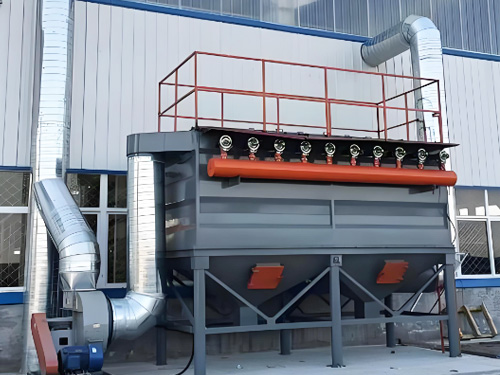Rare Earth Dust CollectorIt Is A Type Of Filter Dust Collector That Uses Fibrous Filter Bags To Capture Dust. The Material Of The Filter Bag Includes Naturally Grown Fibers, Chemically Synthesized Fibers, Glass Fibers, Metal Fibers, And Other Materials. Use These Materials To Manufacture Filter Cloth, And Then Sew The Filter Cloth Into Various Shapes Of Filter Bags, Such As Circular, Fan-shaped, Corrugated, Or Diamond Shaped. When Using A Filter Bag To Filter And Separate Dust Particles, The Dusty Gas Can Enter From The Outside Of The Filter Bag To The Inside, Separating The Dust On The Outer Surface Of The Filter Bag, Or The Dusty Gas Can Flow From The Inside Of The Filter Bag To The Outside, Separating The Dust On The Inner Surface Of The Filter Bag. The Dust Containing Gas Is Filtered Through Filter Bags To Complete The Dust Removal Process.
The Main Structural Components Of A Rare Earth Dust Collector Are As Follows: Bottom Column Component, Sliding Block Component, Top Column Component, Ash Hopper Component (including Three-way And Air Volume Regulating Valve, If Any), Air Inlet Device, Middle Box, Upper Box, Spraying System, Offline Device, Internal Bypass Device (external Bypass, Optional), Platform Escalator, Rain Shelter, Air Piping And Control Components, Etc.
The Working Principle Of Rare Earth Dust Collector: The Dust Containing Gas Enters Each Unit Through The Guide Pipe, And The Large Particle Dust Is Separated And Directly Falls Into The Ash Hopper. The Remaining Dust Flows Into The Filtering Area Of The Middle Box With The Gas. The Filtered Clean Gas Passes Through The Filter Bag And Is Discharged Through The Upper Box And Exhaust Pipe As The Filtering Process Progresses. When The Surface Area Of The Filter Bag Reaches A Certain Amount Of Dust, The Cleaning Control Device (differential Pressure Or Timing, Manual Control) Opens The Electromagnetic Pulse Valve According To The Set Program To Blow, Shake Off The Dust On The Filter Bag, And The Dust That Penetrates Into The Ash Hopper Is Discharged Through The Ash Conveying System.
The Dusty Gas Enters The Lower Box Through The Inlet Of The Dust Collector. Due To The Coarse Particles Falling Directly Into The Ash Hopper Or Ash Bin, The Rest Enters The Upper Box Through The Filter Bag, And The Various Effects Of The Filter Bag Are Utilized. Separate The Dust And Gas, And The Dust Is Adsorbed On The Filter Bag, While The Gas Enters The Upper Box Through The Filter Bag And Is Discharged From The Air Outlet. During The Process Of Purifying Dusty Gases Through Filter Bags, As Time Increases, More And More Dust Accumulates On The Filter Bags, Causing The Resistance Of The Filter Bags To Gradually Increase. The Amount Of Gas Passing Through The Filter Bags Gradually Decreases. In Order To Ensure The Normal Operation Of The Dust Collector, The Resistance Should Be Controlled Within A Limited Range (generally 120-150 Millimeters Of Water Column). When The Resistance Rises To A Limited Range, The Controller Will Issue Instructions To Trigger Each Control Valve In Sequence And Open The Pulse Valve. The Compressed Air Inside The Air Bag Is Sprayed Into The Corresponding Filter Bags Through The Holes Of The Blowing Tube And The Venturi Tube. The Filter Bags Rapidly Expand Under The Instantaneous Reverse Action Of The Airflow, Causing The Dust Accumulated On The Surface Of The Filter Bags To Fall Off, And The Filter Bags Are Produced. The Cleaned Dust Falls Into The Ash Hopper And Is Discharged From The Machine Body By The Worker Opening The Plug Valve. The Dust Accumulated On The Filter Bag Is Regularly Removed, And The Purified Gas Passes Through Normally. After All The Filter Bags Are Blown And Cleaned, The Dust Collector Returns To Normal. It Can Protect The Dust Collector From Working Normally.




